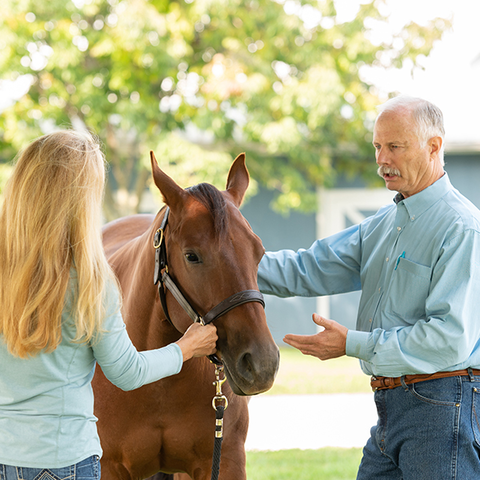Equine influenza tops list for second straight year

New data highlights the impact of antigenic drift. Check out the research to understand the effect on influenza vaccination strategies.
For the second year in a row, equine influenza cases have surpassed all other infectious upper respiratory diseases in horses.1 The incidence of equine influenza virus (EIV) has been trending upward since 2008, with considerable spikes in recent years.1,2
Researchers have been actively studying this trend, the reasons behind it, and the best strategies for protecting horses against highly contagious EIV. Three findings are clear:
-
EIV strains are undergoing significant antigenic drift (evolutionary changes or mutations that lead to new virus strains the immune system doesn’t recognize) and this antigenic drift is the most probable cause for the increased incidence of influenza vaccine failure in the U.S.3
-
Ongoing sequencing of real-world influenza isolates infecting U.S. horses demonstrates significant antigenic differences in field isolates and isolates contained within most vaccine strains, thus inhibiting their ability to offer adequate protection against current circulating strains of equine influenza.
-
Only the Florida ’13 vaccine strain aligns well with current field strains causing infection.1,4
Vaccine strains matter—genetic sequencing tells us so
Genetic sequencing is used to understand the significance of antigenic drift and its impact on vaccine effectiveness. Different strains of EIV are compared by sequencing the hemagglutinin (HA) gene. HA contains the receptor-binding sites that enable the influenza virus to attach to host cells. Vaccination produces antibodies that bind to the HA, which inhibits the virus from attaching to the host cell. If antigenic drift decreases binding of vaccine antibodies with the HA glycoprotein at these “key sites,” it may cause reduced vaccine protection or even a total lack of protection.
“While genetic analysis (sequencing) compares various strains and determines their homology (similarities), the number of single amino acid changes is not what’s relevant,” explains Kyuyoung Lee, DVM, MPVM, PhD, University of California, Davis. “Instead, the important focus is the position of the amino acid changes as they pertain to immunodominant sites, which is determined through sequencing.”
Dr. Lee has conducted research evaluating whether U.S. influenza vaccine failure rates were a result of antigenic drift or the introduction of foreign strains.
“Antigenic drift of EIV in the United States is the likely reason for vaccine failure and vaccine strains should be updated,” he concludes.
For further evaluation, a wide-ranging sequencing study compared commercially available inactivated influenza vaccine strains to 54 positive equine influenza samples isolated through the Equine Respiratory Biosurveillance Program, which is managed by Merck Animal Health in partnership with UC Davis Equine Infectious Disease Research Laboratory. The case samples were collected between February 2013 and July 2020 from influenza outbreaks in 20 U.S. states.1 Investigators found:
-
All 54 positive samples were identical at eight key sites of the HA glycoprotein;
-
Only the Florida ’13 vaccine strain had 100 percent alignment with all eight of these key immunodominant sites;
-
The Ohio ’03 vaccine strain was similar at two key sites with the 54 positive samples; and,
-
Kentucky ’97 shared no key site similarity with the 54 positive samples.
Vaccine timing and choice critical to controlling EIV
Results from the sequencing study also revealed wide variation among vaccines,4 and data clearly indicates that equine flu season ranges from December through April.2 This means veterinarians may benefit from critically evaluating which EIV vaccine to use and when.
Administering biannual EIV vaccines just one or two months earlier in the year could make a significant difference for the horse. The documented impact of antigenic drift on vaccine effectiveness highlights the importance of vaccine choice in helping protect horses. The good news: Evidence supports the role of Florida ’13 in combating today’s equine influenza threat.
For more information on the PRESTIGE line of flu-containing vaccines, featuring Florida ’13, talk to your Merck Animal Health sales representative, Covetrus representative or visit merck-animal-health-usa.com/species/equine.
Copyright © 2021 Intervet Inc., d/b/a Merck Animal Health, a subsidiary of Merck & Co., Inc.
Image courtesy of Merck Animal Health.
Sources:
1 Merck Animal Health and University of California, Davis, School of Veterinary Medicine (Nicola Pusterla). Infectious Upper Respiratory Disease Surveillance Program. Ongoing research 2008-present.
2 Vaala W, Barnett DC, James K, Chappell D, Craig B, Gaughan E, Bain F, Barnum SM, Pusterla N. Prevalence Factors Associated with Equine Influenza Virus Infection in Equids with Upper Respiratory Tract Infection from 2008 to 2019. AAEP Proceedings. 2019 Vol 65.
3 Lee K, Pusterla N, Barnum S, Martinez-Lopez B. Is Current Vaccine Failure of Equine Influenza Virus Due to Evolution of Endemic Strains or Introduction of Foreign Strains? AAEP Proceedings. 2019 Vol 65.
4 Data on file, Merck Animal Health (2013-2020).
Need Regulatory Assistance
If you need help with regulatory or licensing issues, we're happy to help. We have a wide variety of resources to help you when issues arise.

Careers
Are you looking for a place to let your talents shine? At Covetrus, we help our practitioner customers better serve their patients and take pride in providing the best customer experience possible. Search our open positions to see our available opportunities.
Newsletter
Stay current with what’s going on with Covetrus, subscribe to receive our newsletter and email communications. Subscribers will receive the latest information in practice management, sales and marketing, animal health, and more.


Leave a comment